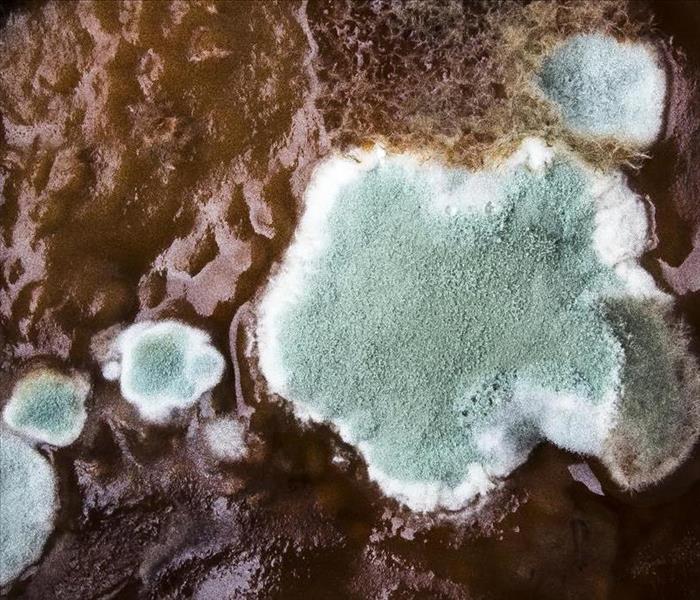When And How Does Mold Get Into Homes?
12/28/2022 (Permalink)
How Does Mold Get Into Your Home?
Even a small water leak or excess humidity allows a mold colony to form in your Huron & East Seneca Counties home. Once a mold colony has set in, it can spread quickly through your property and become a severe problem in as little as 48 hours.
Such mold growth is not only unappealing for a home or business, but it can also produce allergens and irritants that have the potential to impact the health of anyone in your home negatively.
What Do I Need To Know About Mold?
Some restoration companies advertise “mold removal” and may even guarantee to remove all mold. However, removing all mold from a house or business is impossible. Microscopic mold spores exist almost everywhere, both indoors and outdoors. Here are the facts:
- Mold is present almost everywhere, indoors and outdoors.
- Mold spores are microscopic and float along in the air and may enter your home through windows, doors, or AC/heating systems or even hitch a ride indoors on your clothing or a pet.
- Mold spores thrive on moisture. Mold spores can quickly grow into colonies when exposed to water. These colonies may produce allergens and irritants.
- Before mold remediation begins, any water or moisture sources must be addressed. Otherwise, the mold may return.
- Mold often produces a strong, musty odor and can lead you to possible mold problem areas.
- Even higher-than-normal indoor humidity can support mold growth. Keep indoor humidity below 45 percent.
Why Is SERVPRO Of Huron & East Seneca Counties My Best Choice For Mold Remediation?
Every mold damage scenario is different and requires a unique solution, but the general mold remediation process stays the same. The steps listed below illustrate our “typical” process:
- Emergency Contact - (419) 443-1790. Our mold cleanup and restoration processes begin when you call us. Our representative will ask questions to help us determine the necessary equipment, resources, and personnel.
- Inspection and Mold Damage Assessment. Local and state laws may require a specific inspection and documentation protocol based on the size of the affected area. We can advise you on this process, providing guidance based on your unique situation. We carefully inspect your property for visible signs of mold. Mold feeds on cellulose and water and can be hidden from plain view. We use various technologies to detect mold and hidden water sources.
- Mold Containment. Our professionals use various containment procedures to prevent the spread of mold. We may use advanced containment procedures like negative air chambers to isolate the contaminated area with physical barriers and negative air pressure to prevent mold spores from spreading during the cleanup process. All fans and heating and cooling systems will be turned off to prevent the spread of mold.
- Air Filtration. Our specialized filtration equipment allows our Professionals to capture microscopic mold spores out of the air. We utilize powerful “air scrubbers” and HEPA vacuums to prevent the spread of these mold spores while mold remediation is in process.
- Removing Mold and Mold-Infested Materials. The mold remediation process depends on mold growth and the types of surfaces on which the mold appears. We’ll use antifungal and antimicrobial treatments to eliminate mold colonies and to help prevent new colonies from forming. Removing and disposing of mold-infested porous materials, like drywall and carpeting, may be necessary to remediate heavy mold growth.
- Cleaning Contents and Belongings. We clean your furniture, decorative items, curtains, clothing, and other restorable items affected by mold. We use a variety of cleaning techniques to clean and disinfect your belongings. We’re also trained to remove odors and deodorization using fogging equipment.
- Restoration. Depending on the level of mold damage, drywall, subfloors, and other building materials may have been removed. Restoration may involve minor repairs, such as replacing drywall, painting, and installing new carpet, or significant repairs, such as the reconstruction of various areas or rooms in a home or business. The restoration step gets your home or business back to normal.
SERVPRO of Huron & East Seneca Counties can be onsite immediately to help you in any disaster, regardless of type or size. From mold remediation and water damage restoration to odor removal and fire damage restoration and much more, we are here to help!
This franchise is independently owned and operated.






 24/7 Emergency Service
24/7 Emergency Service
